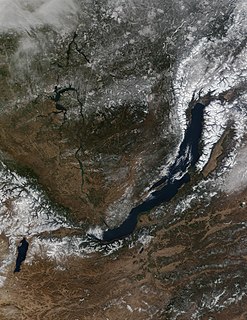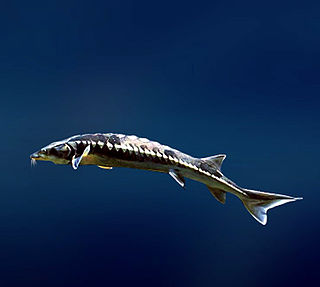
Lake Baikal is a rift lake located in Russia situated in southern Siberia between the federal subjects of Irkutsk Oblast to the northwest and Buryatia to the southeast.

The Yenisey, also romanised as Yenisei, Enisei, or Jenisej, is the fifth-longest river system in the world, and the largest to drain into the Arctic Ocean. Rising in Mungaragiyn-gol in Mongolia, it follows a northerly course before draining into the Yenisey Gulf in the Kara Sea. The Yenisey divides the Western Siberian Plain in the west from the Central Siberian Plateau to the east; it drains a large part of central Siberia.

Sturgeon is the common name for the 27 species of fish belonging to the family Acipenseridae. The earliest sturgeon fossils date to the Late Cretaceous, and are descended from other, earlier acipenseriform fish, which date back to the Early Jurassic epoch, some 174 to 201 million years ago. The family is grouped into four genera: Acipenser, Huso, Scaphirhynchus, and Pseudoscaphirhynchus. Two species may be extinct in the wild, and one may be entirely extinct. Two closely related species, Polyodon spathula and Psephurus gladius are of the same order, Acipenseriformes, but are in the family Polyodontidae and are not considered to be "true" sturgeons. Both sturgeons and paddlefish have been referred to as "primitive fishes" because their morphological characteristics have remained relatively unchanged since the earliest fossil record. Sturgeons are native to subtropical, temperate and sub-Arctic rivers, lakes and coastlines of Eurasia and North America.
Acipenser is a genus of sturgeons. With 17 living species, it is the largest genus in the order Acipenseriformes. They are native to freshwater and estuarine systems of Eurasia and North America, and most species are threatened. Several species also known to enter near-shore marine environments in the Atlantic, Arctic and Pacific oceans.
The lake sturgeon, also known as the rock sturgeon, is a North American temperate freshwater fish, one of about 25 species of sturgeon. Like other sturgeons, this species is an evolutionarily ancient bottom feeder with a partly cartilaginous skeleton, an overall streamlined shape and skin bearing rows of bony plates on its sides and back. The fish uses its elongated, spade-like snout to stir up the substrate and sediments on the beds of rivers and lakes while feeding. The lake sturgeon has four purely sensory organs that dangle near its mouth. These organs, called barbels, help the sturgeon to locate bottom-dwelling prey. Lake sturgeons can grow to a relatively large size, topping 7.25 ft long and weighing over 240 lb (108 kg).

Ossetra caviar is one of the most prized and expensive types of caviar. It is obtained from the Ossetra sturgeon which weighs 50-400 pounds and can live up to 50 years.
Sevruga caviar is one of the highest priced varieties of caviar, eclipsed in cost only by the Beluga and Ossetra varieties. It is harvested from a variety of critically endangered sturgeon fish species, that are known for their small, grey colored eggs. In eastern Europe, it is harvested from the Sevruga sturgeon, the Sterlet sturgeon and the Siberian sturgeon, which are native to the Caspian Sea and the surrounding rivers.

The European sea sturgeon, also known as the Atlantic sturgeon or common sturgeon, is a species of sturgeon endemic to France. It was formerly abundant, being found in coastal habitats all over Europe. It is anadromous and breeds in rivers. It is currently a critically endangered species. Although the name Baltic sturgeon sometimes has been used, it has now been established that sturgeon of the Baltic region are A. oxyrinchus, a species otherwise restricted to the Atlantic coast of North America.

White sturgeon is a species of sturgeon in the family Acipenseridae of the order Acipenseriformes. They are an anadromous fish species ranging in the Eastern Pacific; from the Gulf of Alaska to Monterey, California. However, some are landlocked in the Columbia River Drainage, Montana, and Lake Shasta in California, with reported sightings in northern Baja California, Mexico.

The starry sturgeon also known as stellate sturgeon or sevruga, is a species of sturgeon. It is native to the Black, Azov, Caspian and Aegean sea basins, but it has been extirpated from the last and it is predicted that the remaining natural population will follow soon due to overfishing.

The Persian sturgeon is a species of fish in the family Acipenseridae. It is found in the Caspian Sea and to a lesser extent the Black Sea and ascends certain rivers to spawn, mainly the Volga, Kura, Araks and Ural Rivers. It is heavily fished for its flesh and its roe and is limited in its up-river migrations by damming of the rivers. Young fish feed on small invertebrates, graduating to larger prey such as crabs and fish as they grow. The threats faced by this fish include excessive fishing with the removal of immature fish before they have bred, damming of the rivers, loss of spawning areas and water pollution. The International Union for Conservation of Nature has listed the fish as critically endangered and has suggested that the increased provision of hatcheries could be of benefit.

The Siberian sturgeon is a species of sturgeon in the family Acipenseridae. It is most present in all of the major Siberian river basins that drain northward into the Kara, Laptev and East Siberian Seas, including the Ob, Yenisei Lena, and Kolyma Rivers. It is also found in Kazakhstan and China in the Irtysh River, a major tributary of the Ob. The species epithet honors the German Russian biologist Karl Ernst von Baer.

Dabry's sturgeon, also known as the Yangtze sturgeon, Chiangjiang sturgeon and river sturgeon, is a species of fish in the sturgeon family, Acipenseridae. It is endemic to China and today restricted to the Yangtze River basin, but was also recorded from the Yellow River basin in the past. It was a food fish of commercial importance. Its populations declined drastically, and in the early 1980s, it was designated an endangered species on the Chinese Red List and commercial harvest was banned. It has been listed as a Critically Endangered species by the IUCN since 1996.

The Russian sturgeon, also known as the diamond sturgeon or Danube sturgeon, is a species of fish in the family Acipenseridae. It is found in Azerbaijan, Bulgaria, Georgia, Iran, Kazakhstan, Romania, Russia, Turkey, Turkmenistan, and Ukraine. It is also found in the Caspian Sea. This fish can grow up to about 235 cm (93 in) and weigh 115 kg (254 lb). Russian sturgeon mature and reproduce slowly, making them highly vulnerable to fishing. It is distinguished from other Acipenser species by its short snout with a rounded tip as well as its lower lip which is interrupted at its center.

The Sakhalin sturgeon is a species of fish in the family Acipenseridae. It is found in Japan and Russia.

The Adriatic sturgeon is a species of fish in the family Acipenseridae. It is native to the Adriatic Sea and large rivers which flow in it of Albania, Greece, Italy, and states of former-Yugoslavia. Specimens can be seen in several public aquarium, such the Milan Aquarium, Aquarium Finisterrae, Aquarium of the Po, and Oasis of Sant'Alessio in Lombardy.

The ship sturgeon, also known as the fringebarbel sturgeon, ship sturgeon, spiny sturgeon, or thorn sturgeon, is a species of fish in the family Acipenseridae. These fish are typically found along the benthos of shallower waters near shorelines or estuaries.

The Japanese sturgeon, or Amur sturgeon is a species of fish in the family Acipenseridae found in the Amur River basin in China and Russia. Claims of its presence in the Sea of Japan need confirmation. The species has 11–16 dorsal, 34–47 lateral, and 7–16 ventral scutes. Their dorsal fins have 38–53 rays and 20–35 anal fin rays. They also have greyish-brown backs and pale ventral sides. The species could reach up to 3 m (9.8 ft) in length, and weight over 190 kg. The species is considered to be critically endangered.

This list is of the heaviest European freshwater fish caught using the traditional angling method of rod and line.


















